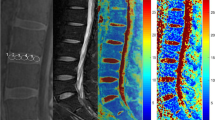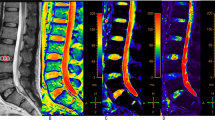Abstract
Purposes
To analyze T2 relaxation times of the facet joint by MRI T2-mapping in patients with degenerative lumbar disorders (DLD), and to determine the correlation with lumbar instability in radiographs.
Methods
We conducted a T2-mapping of the lumbar facet joint using a 1.5 T MRI system. We classified patients with degenerative lumbar disorders scheduled to undergo decompression surgery into groups with stability and instability using radiographs, and compared the T2 relaxation times of the lumbar facet. Lumbar instability was defined as the presence of anterior translation ratio > 5% or disk range of motion (ROM) > 5° in the sagittal plane of SLFE radiographs.
Results
Inclusion criteria were met by 22 patients (45 levels, mean age 64.3 years). Facet effusions had high sensitivity (90%) but had low specificity (28%) for diagnosis of lumbar instability. Mean T2 relaxation times of right and left facet joints are significantly longer (98.4 ms) in the instability group than they are (87.6 ms) in the stability group (p < 0.001). Anterior translation ratio was positively correlated with mean T2 relaxation times of facet joint (R2 = 0.493, p < 0.05). From a ROC analysis, the cutoff value of T2 relaxation times for lumbar instability was 98.65 ms (sensitivity 60.0%, specificity 95.7%, AUC 0.763).
Conclusions
The T2 relaxation times were positively correlated with lumbar instability. This new quantitative evaluation of lumbar facet joint using MRI T2-mapping might be useful to determine lumbar instability.










Similar content being viewed by others
References
Rihn JA, Lee JY, Khan M, Ulibarri JA, Tannoury C, Donaldson WF 3rd, Kang JD (2007) Does lumbar facet fluid detected on magnetic resonance imaging correlate with radiographic instability in patients with degenerative lumbar disease? Spine (Phila PA 1976) 32(14):1555–1560
Fujiwara A, Tamai K, Yamato M, An HS, Yoshida H, Saotome K, Kurihashi A (1999) The relationship between facet joint osteoarthritis and disc degeneration of the lumbar spine: an MRI Study. Eur Spine J 8(5):396–401
Chaput C, Padon D, Rush J, Lenehan E, Rahm M (2007) The significance of increased fluid signal on magnetic resonance imaging in lumbar facets in relationship to degenerative spondylolisthesis. Spine (Phila Pa 1976) 32(17):1883–1887
Lattig F, Fekete TF, Grob D, Kleinstück FS, Jeszenszky D, Mannion AF (2012) Lumbar facet joint effusion in MRI: a sign of instability in degenerative spondylolisthesis? Eur Spine J 21(2):276–281
Nieminen MT, Rieppo J, Töyräs J, Hakumäki JM, Silvennoinen J, Hyttinen MM, Helminen HJ, Jurvelin JS (2001) T2 relaxation reveals spatial collagen architecture in articular cartilage: a comparative quantitative MRI and polarized light microscopic study. Magn Reson Med 46(3):487–493
Watanabe A, Benneker LM, Boesch C, Watanabe T, Obata T, Anderson SE (2007) Classification of intervertebral disk degeneration with axial T2 mapping. AJR Am J Roentgenol 189(4):936–942
Takashima H, Takebayashi T, Yoshimoto M, Terashima Y, Ida K, Shishido H, Imamura R, Akatsuka Y, Shirase R, Fujiwara H, Kubo T, Yamashita T (2014) Investigation of intervertebral disc and facet joint in lumbar spondylolisthesis using T2 mapping. Magn Reson Med Sci 13(4):261–266
Enokida S, Tanishima S, Tanida A, Mihara T, Takeda C, Yamashita E, Nagashima H (2020) Evaluation of age-related changes in lumbar facet joints using T2 mapping. J Orthop Sci 25:46–51
Jeffrey AR, Joon YL, Mustafa K, James AU, Chadi T, William FD, James DK (2007) Does lumbar facet fluid detected on magnetic resonance imaging correlate with radiographic instability in patients with degenerative lumbar disease? Spine (Phila Pa 1976) (32):1555–1560
Schwab F, Patel A, Ungar B, Farcy JP, Lafage V (2010) Adult spinal deformity-postoperative standing imbalance: how much can you tolerate? An overview of key parameters in assessing alignment and planning corrective surgery. Spine (Phila Pa 1976) 35(25):2224–2231
Leonid K, Pradeep S, Ali G, Ling L, David JH (2009) Facet orientation and tropism: associations with facet joint osteoarthritis and degenerative spondylolisthesis. Spine (Phila Pa 1976) 34(16):E579–E585
Fujiwara A, Lim TH, An HS, Tanaka N, Jeon CH, Andersson GB, Haughton VM (2000) The effect of disc degeneration and facet joint osteoarthritis on the segmental flexibility of the lumbar spine. Spine (Phila Pa 1976) 25(23):3036–3044
Grogan J, Nowicki BH, Schmidt TA, Haughton VM (1997) Lumbar facet joint tropism does not accelerate degeneration of the facet joints. AJNR Am J Neuroradiol 18(7):1325–1329
Caterini R, Mancini F, Bisicchia S, Maglione P, Farsetti P (2011) The correlation between exaggerated fluid in lumbar facet joints and degenerative spondylolisthesis: prospective study of 52 patients. J Orthop Traumatol 12(2):87–91
Kirkaldy-Willis (1985) Presidential symposium on instability of the lumbar spine. Spine 10:254
Wang D, Yuan H, Liu A, Li C, Yang K, Zheng S, Wang L, Wang JC, Buser Z (2017) Analysis of the relationship between the facet fluid sign and lumbar spine motion of degenerative spondylolytic segment using Kinematic MRI. Eur J Radiol 94:6–12
Lattig F, Fekete TF, Kleinstück FS, Porchet F, Jeszenszky D, Mannion AF (2015) Lumbar facet joint effusion on MRI as a sign of unstable degenerative spondylolisthesis: should it influence the treatment decision? J Spinal Disord Tech 28(3):95–100
Tamai K, Kato M, Konishi S, Matsumura A, Hayashi K, Nakamura H (2017) Facet effusion without radiographic instability has no effect on the outcome of minimally invasive decompression surgery. Global Spine J 7(1):21–27
Miyashita T, Ataka H, Kato K, Tanno T (2015) Good clinical outcomes and fusion rate of facet fusion with a percutaneous pedicle screw system for degenerative lumbar spondylolisthesis: minimally invasive evolution of posterolateral fusion. Spine (Phila Pa 1976) 40(9):E552–E557
Author information
Authors and Affiliations
Corresponding author
Ethics declarations
Conflict of interest
All authors declare that they have no conflict of interest.
Additional information
Publisher's Note
Springer Nature remains neutral with regard to jurisdictional claims in published maps and institutional affiliations.
Rights and permissions
About this article
Cite this article
Iwata, S., Eguchi, Y., Takaoka, H. et al. MRI T2-mapping of lumbar facet joints is effective for quantitative evaluation of lumbar instability in patients with degenerative lumbar disorders. Eur Spine J 31, 1479–1486 (2022). https://doi.org/10.1007/s00586-022-07119-9
Received:
Revised:
Accepted:
Published:
Issue Date:
DOI: https://doi.org/10.1007/s00586-022-07119-9




